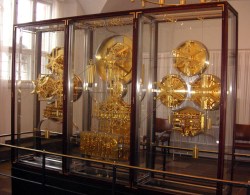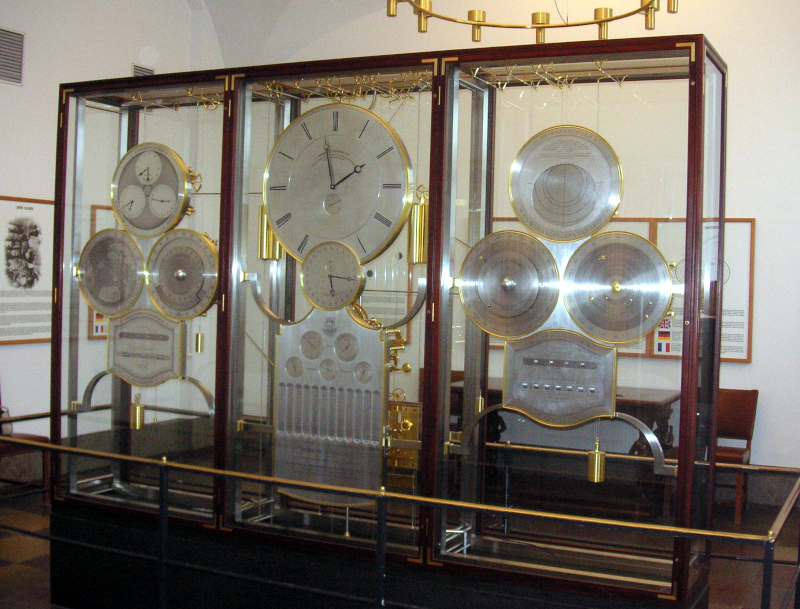If you visit the Copenhagen City Hall, you’ll see an ornate mechanical clock. By itself, this is unremarkable, of course. There are plenty of ornate clocks in city halls around the world, but this one has a fascinating backstory that starts with a locksmith named Jan Jens Olsen. Unfortunately, Jens didn’t actually complete the clock before his death. It would take 12 years to put together the 15,448 individual parts. However, he did manage to see most of the clock that he had been designing for 50 years put together.
Jens was 60 when he started constructing the clock, but the story starts when he was only 25. In Strasbourg, the young locksmith saw an astronomical clock with a perpetual calendar in a cathedral. He was fascinated and returned several times to study the mechanism. Around the age of 30, Jens had moved to watchmaking and had a keen interest in astronomy — he was a founding member of the Danish Astronomical Society. Perhaps it was the combination of these two interests that made it inevitable that he would want to build a precise astronomically-correct clock.
Finish Line
The clock garnered national attention and received funding from a variety of sources. It was well known that when a seemingly-insoluble problem would arise, Jens would solve it in a way that left his workers amazed. Unfortunately, Jens died near the end of 1945 with only 10 of the 11 parts of the clock actually under construction. His apprentice, Otto Mortensen had to take over, leaving King Frederik IX and Olsen’s granddaughter set the clock in motion on December 15, 1955.
Dials and More Dials
There are three major sections to the clock. The left section’s top dial shows the local time and the actual solar time. There is a dial to the left that can show the time at any location on the planet. A dial to the right has a black and white portion that shows sunrise, sunset, and the length of both day and night. There is also a calendar in this section that shows the year, the date, and the day of the week.

The middle section shows the local mean time. In addition, it shows the moon phase and several holidays, such as Easter Sunday. The right section shows the star map over Denmark and information about solar and lunar eclipses, along with associated data such as the distance between the Earth and the moon. There’s also a model of the solar system showing the position of the configuration of planets around the sun. This section also shows the Jullian date.
Of course, you could program all of this into your Raspberry Pi. But in the 1940s and 1950s, this would have required a roomful of computers. And this is a mechanical movement that only requires winding once a week. Not too shabby. The fastest gear rotates at 6 RPM, and the slowest turns once every 25,753 years! The winding is a chore, as seen in [Patrick Limoges’] home video below.
Restoration
Did we mention this is supposed to be the most precise mechanical clock in the world? At least, that’s true after some restoration work to improve the fix frozen bearings. The restoration included cleaning, adding ball bearings and Teflon to surfaces, and repainting many markings in a way that will last longer. The parts are mostly brass made from melted-down kitchen utensils. However, many parts are now coated with rhodium for wear resistance. There’s also 4 kg of gold gilding for aesthetics.
Dekatrons make a great-looking retro clock, but nothing like the Olsen clock. You can build something like the Olsen clock, though, if you have the patience for it.
















You managed to misspell his name only 8 times
Jens: https://en.wikipedia.org/wiki/Jens_Olsen
That’s finger memory for you…
That makes “Jens” to me…
great title! love it.
Wow ! This is so amazing! He will be remembered forever for creating a precision work of art. Whoever created the clock app for your cellphone most likely won’t be.
IIRC, I saw this clock years ago on a Hackaday blog.
Maybe it was through a supplemental link.
Dear Hackaday, Why can I click on the thumbnail of the back view of the clock to get a 2163×1692 image but not the headline image of the front of the clock? It would have made reading the section “Dials and more dials” much richer.
Huh. Article states 5 micron gilding. 4 kg of gold is like … a whole lot of gold.
My probably bad maths says 19.3g/cm3, 0.0005cm thick equals around 414,508cm2, or 41.45 square meters of gilding. Or 450 square feet if you live in one country. Or US$236,000 worth of bullion if you meant a different kind of “a lot”
yeah sorry, I meant that there is no way they used 4kg of gold. Or, at least I doubt it. Goldleav is vapor thin. Even 41 m^2 wouldn’t be anywhere near 4kg, but my math could be totally off too.
Didn’t we see this covered in HAD before? But still a great piece of art/engineering.
I’m waiting for the “I can build this on my laser cutter” answers :-)
I saw this in person about 4 years ago and it is stunning if you like mechanical things and/or shiny things. It is also big. If you wander round the building it is in, it is easy to miss, I did on my first walk about and went back in to see it. No disappointed.
“winding is a chore”
A chore???
It would be a privilege!
A chore would be getting to the roof of our Town Hall, climbing the exposed 10 foot ladder once a week in windy sub-zero weather, and rewinding that clock!
(And it would still be a privilege!)
Kids these days!